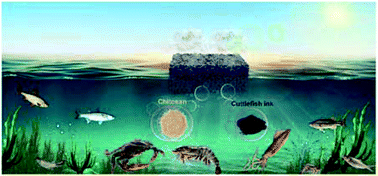Seawater desalination derived entirely from ocean biomass†
Abstract
Solar-driven interfacial evaporation shows great prospects for seawater desalination with its rapid fast evaporation rate and high photothermal conversion efficiency. Here, a sustainable, biodegradable, non-toxic, and highly efficient full ocean biomass-based solar-driven evaporator is reported, which is composed of chitosan (CS) hydrogel as the hydratable skeleton and cuttlefish ink (CI) as the photothermal material. Under solar irradiation, the cuttlefish ink powder harvests solar energy and heats the surrounding water. Simultaneously, the water in the three-dimensional network of chitosan hydrogel is rapidly replenished by the interconnected porous structure and the hydrophilic functional groups attached to the polymer chains. With its enlarged evaporation surface, high solar absorptance, adequate water transportation, good salt drainage, and heat localization, the CI/CS-based evaporator achieves a remarkable evaporation rate of 4.1 kg m−2 h−1 under one sun irradiance (1 kW m−2) with high-quality freshwater yields. This full ocean biomass-based evaporator with abundant raw material availability provides new possibilities for an efficient, stable, sustainable, and environmentally friendly solar evaporator with guaranteed water quality.



 Please wait while we load your content...
Please wait while we load your content...
